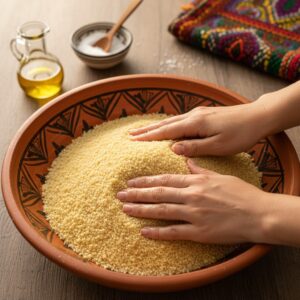A chorba is a hearty, comforting soup that originates from North Africa. The word “chorba” itself comes from the Arabic term “شوربة” (shurba), meaning “to cook in liquid”. This type of soup has been a staple in many North African countries for centuries, and each country has its own unique variation. Chorbas are typically made with a rich broth, vegetables, beans, and sometimes meat or seafood. They’re often served as a main course or used as a base for other dishes.
The history of chorba dates back to the medieval period in North Africa, when it was a staple food for many communities. Chorbas were often cooked in large quantities and served at communal gatherings, such as weddings and festivals. The soup became an integral part of North African cuisine, with each country adding its own twist and ingredients.
Over time, chorba evolved to reflect the cultural exchange between different regions and empires. For example, the Ottoman Empire introduced new spices and cooking techniques that influenced the development of chorba in countries like Turkey and Algeria. Meanwhile, European traders brought their own culinary traditions, such as tomatoes and garlic, which were incorporated into chorbas.
Today, chorba remains a beloved dish across North Africa, with each country boasting its unique version. From Morocco to Tunisia, Algeria to Libya, chorba is a symbol of community, hospitality, and cultural heritage.
Tunisia: A Country of Rich History and Culture
Located in the heart of North Africa, Tunisia is a small but vibrant country with a rich history and culture. Situated between the Mediterranean Sea and the Sahara Desert, Tunisia has been an important crossroads for trade, commerce, and cultural exchange throughout its 2,500-year history. The country is home to a diverse population, including Arabs, Berbers, and Europeans, each leaving their mark on Tunisian cuisine.
Tunisia’s capital city, Tunis, is a treasure trove of history and culture. Visitors can explore the ancient medina (old town), with its narrow streets, colorful markets, and stunning architecture. The city is also home to several UNESCO World Heritage Sites, including the famous Bardo Museum, which houses an impressive collection of Roman mosaics.
Recipe: Tunisian Chorba
Servings: 6-8
Ingredients:
- 1 pound beef or lamb, cut into small pieces
- 2 medium onions, chopped
- 3 cloves garlic, minced
- 2 medium carrots, peeled and grated
- 2 stalks celery, chopped
- 1 can (14.5 oz) diced tomatoes
- 4 cups vegetable broth
- 1 teaspoon ground cumin
- 1 teaspoon paprika
- Salt and black pepper to taste
- Fresh parsley or cilantro for garnish
Instructions:
- Heat oil in a large pot over medium heat. Add the meat, onions, garlic, carrots, and celery. Cook until the vegetables are tender, about 10 minutes.
- Add the diced tomatoes, vegetable broth, cumin, paprika, salt, and pepper. Bring to a boil, then reduce the heat to low and simmer for 30 minutes.
- Taste and adjust the seasoning as needed.
- Serve hot, garnished with fresh parsley or cilantro.
Conclusion: Visiting Algeria, Morocco, and Tunisia
If you’re planning a trip to North Africa, consider visiting Algeria, Morocco, and Tunisia. Each country has its unique charm, history, and culture waiting to be discovered. From the bustling souks (markets) of Marrakech to the ancient city of Carthage in Tunisia, there’s no shortage of excitement and adventure.
In Algeria, visit the stunning Sahara Desert, where you can experience the hospitality of the Tuareg people. In Morocco, explore the vibrant cities of Fez and Rabat, with their rich history and architecture. And in Tunisia, wander through the ancient medina of Tunis, with its colorful markets and stunning architecture.
Whatever your interests – history, culture, food, or adventure – North Africa has something for everyone. So pack your bags, grab a cup of chai (tea), and get ready to immerse yourself in the vibrant cultures of Algeria, Morocco, and Tunisia. Bon appétit!




